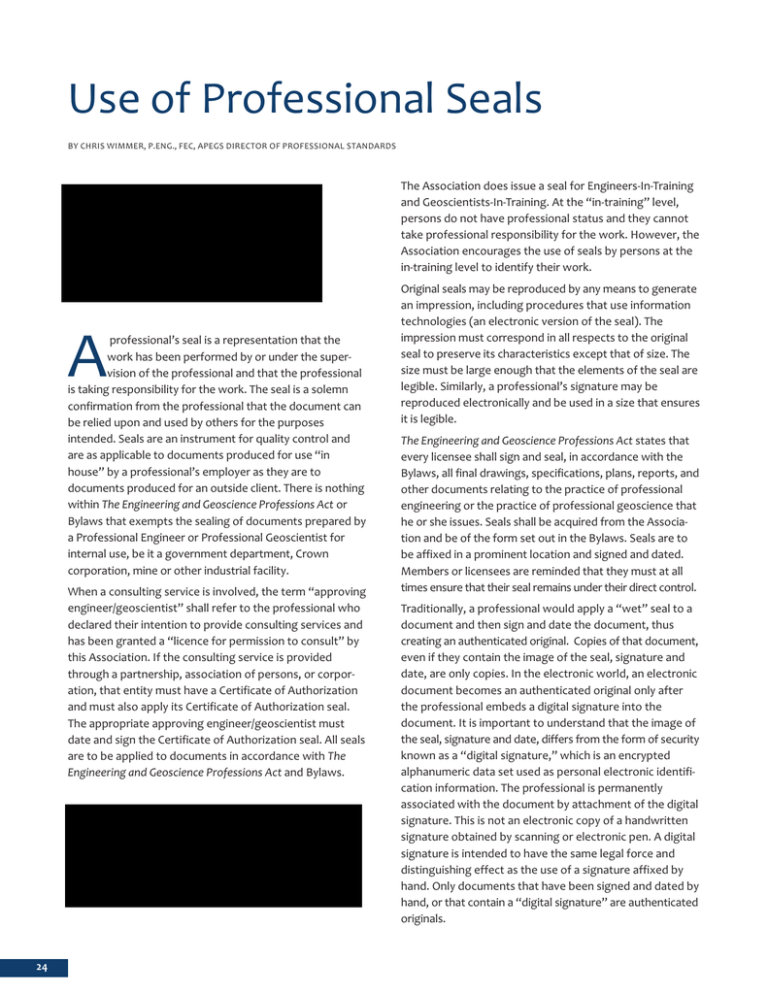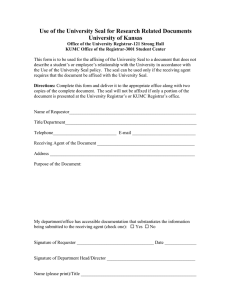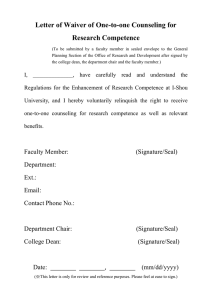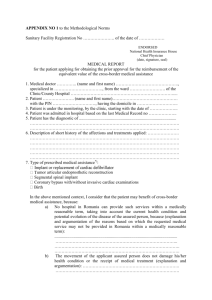Use of Seals
advertisement

Use of Professional Seals bY CHRIS WIMMER, P.ENG., FEC, APEGS DIRECTOR OF PROFESSIONAL STANDARDS A professional’s seal is a representation that the work has been performed by or under the supervision of the professional and that the professional is taking responsibility for the work. The seal is a solemn confirmation from the professional that the document can be relied upon and used by others for the purposes intended. Seals are an instrument for quality control and are as applicable to documents produced for use “in house” by a professional’s employer as they are to documents produced for an outside client. There is nothing within The Engineering and Geoscience Professions Act or bylaws that exempts the sealing of documents prepared by a Professional Engineer or Professional Geoscientist for internal use, be it a government department, Crown corporation, mine or other industrial facility. When a consulting service is involved, the term “approving engineer/geoscientist” shall refer to the professional who declared their intention to provide consulting services and has been granted a “licence for permission to consult” by this Association. If the consulting service is provided through a partnership, association of persons, or corporation, that entity must have a Certificate of Authorization and must also apply its Certificate of Authorization seal. The appropriate approving engineer/geoscientist must date and sign the Certificate of Authorization seal. All seals are to be applied to documents in accordance with The Engineering and Geoscience Professions Act and bylaws. 24 The Association does issue a seal for Engineers-In-Training and Geoscientists-In-Training. At the “in-training” level, persons do not have professional status and they cannot take professional responsibility for the work. However, the Association encourages the use of seals by persons at the in-training level to identify their work. Original seals may be reproduced by any means to generate an impression, including procedures that use information technologies (an electronic version of the seal). The impression must correspond in all respects to the original seal to preserve its characteristics except that of size. The size must be large enough that the elements of the seal are legible. Similarly, a professional’s signature may be reproduced electronically and be used in a size that ensures it is legible. The Engineering and Geoscience Professions Act states that every licensee shall sign and seal, in accordance with the bylaws, all final drawings, specifications, plans, reports, and other documents relating to the practice of professional engineering or the practice of professional geoscience that he or she issues. Seals shall be acquired from the Association and be of the form set out in the bylaws. Seals are to be affixed in a prominent location and signed and dated. Members or licensees are reminded that they must at all times ensure that their seal remains under their direct control. Traditionally, a professional would apply a “wet” seal to a document and then sign and date the document, thus creating an authenticated original. Copies of that document, even if they contain the image of the seal, signature and date, are only copies. In the electronic world, an electronic document becomes an authenticated original only after the professional embeds a digital signature into the document. It is important to understand that the image of the seal, signature and date, differs from the form of security known as a “digital signature,” which is an encrypted alphanumeric data set used as personal electronic identification information. The professional is permanently associated with the document by attachment of the digital signature. This is not an electronic copy of a handwritten signature obtained by scanning or electronic pen. A digital signature is intended to have the same legal force and distinguishing effect as the use of a signature affixed by hand. Only documents that have been signed and dated by hand, or that contain a “digital signature” are authenticated originals. A Professional Engineer or Professional Geoscientist licensed in Saskatchewan must be responsible for all professional engineering and professional geoscience work respectively that is undertaken in Saskatchewan, or for projects located in Saskatchewan. The scope of engineering and geoscience can be determined by referring to the definitions of the practice of professional engineering and the practice of professional geoscience contained in section 2 of The Engineering and Geoscience Professions Act. Professionals must never allow another person to apply their seal on their behalf. Any apparent convenience of pre-sealing title blocks or schedules, or providing others with permission to apply their seal is dramatically outweighed by grave liability and professional conduct consequences. Given the importance of a professional’s seal, it should not be used indiscriminately. The seal is intended for application on documents produced in connection with rendering professional engineering or professional geoscience service. The seal is not, and should not be considered, a certification mark or warranty, or be confused with a corporate business seal. Sealing, signing and dating (collectively referred to as “authentication”) of professional documents is a requirement of The Engineering and Geoscience Professions Act and bylaws. Authentication of documents is indicative of a professional’s involvement and the professional’s acceptance of responsibility for the work contained in the document. For further information on the use of professional seals, please refer to APEGS guide “Authentication of Documents - Use of Professional Seals.” Copies are available from the APEGS office or from the APEGS website, www.apegs.sk.ca. The mere fact that a document is issued by a professional is insufficient grounds to warrant application of the seal. “Record” or “as-built” drawings should not be sealed. Such drawings are largely produced by or based on information provided by others. It is impractical and inherently risky for a professional to attest to the accuracy of “record” documents by applying a signature and seal. Professionals must never apply a seal to any document that is unchecked or not complete for the purposes it is intended. 25


